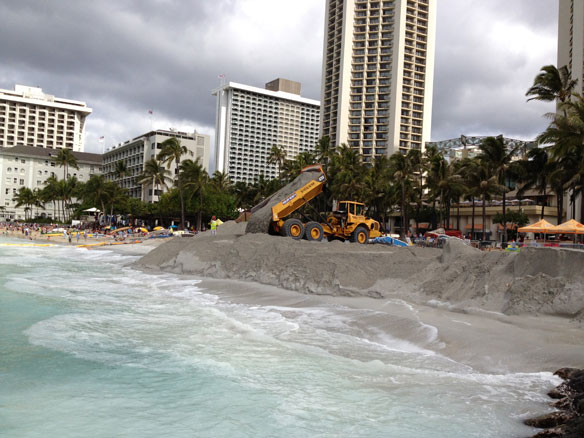Waikiki beach-renourishement. A section of Hawaii’s famed Waikiki Beach is starting to erode, less than a year after the completion of a $2.2 million project to replenish the sand on about 1,730 feet of shoreline that had been suffering from chronic erosion. Captions and Photograph: © SAF — Coastal Care
Excerpts:
A $700,000 — 95-foot-long sand bag groin made of 83, 10,000-pound bags of sand — installed in November to restore the coastline and slow erosion at Kuhio Beach, is to be followed by another more expensive project.
The more than $2 million project — proposed by the DLNR — that will launch next month, will involve replacing the Royal Hawaiian groin with a stable, sloping rock groin, as well as pumping dredged sand in…
‘Sand mattress’ technology to combat Mother Nature at Kuhio Beach; KHON News (12-17-2017)
Waikiki Beach Is Totally Man-Made And Disappearing. Can Hawaii Save It?Huffington Green (03-10-2015)
Waikiki Beach Eroding Less Than A Year After $2.2M Sand Restoration; Pacific Business News (06-24-2013)
A section of Hawaii’s famed Waikiki Beach is starting to erode, less than a year after the completion of a $2.2 million project to replenish the sand on about 1,730 feet of shoreline that had been suffering from chronic erosion…
Doubling of Coastal Erosion by Mid-Century in Hawai’i, Science Daily (03-24-2015)
Chronic erosion dominates the sandy beaches of Hawai’i, causing beach loss as it damages homes, infrastructure, and critical habitat. Researchers have long understood that global sea level rise will affect the rate of coastal erosion. However, new research indicates that coastal erosion of Hawai’i’s beaches may double by mid-century…
Terminal Groins Don’t Stop Erosion; Coastal Review (05-03-2016)
The Negative Impacts Of Groins, (02-12-2009)
The negative impact of groins on downdrift shorelines is well understood. When a groin works as intended, sand moving along the beach in the so-called downdrift direction is trapped on the updrift side of the groin, causing a sand deficit and increasing erosion rates on the downdrift side. This well-documented and unquestioned impact is widely cited in the engineering and geologic literature.
Seawalls: Ecological effects of coastal armoring in soft sediment environments; Science Daily (07-24-2017)
For nearly a century, America’s coasts — particularly those with large urban populations — have been armored with human made structures such as seawalls. These structures essentially draw a line in the sand that constrains the ability of the shoreline to respond to changes in sea level and other dynamic coastal processes…
“Seawalls Kill Beaches,” Open Letters by Warner Chabot And Rob Young; (10-03-2014)
Living on the shores of Hawaii: natural hazards, the environment, and our communities, A book by Chip Fletcher; Robynne Boyd, William J. Neal and Virginia Tice.
“Living on the shores of Hawaii: natural hazards, the environment, and our communities” addresses a wide range of environmental concerns within the context of sustainability and their influence on the future of Hawaii…
70 Percent of Beaches Eroding On Hawaiian Islands Kauai, Oahu, and Maui, USGS (Uploaded 05-08-2012)
Hawaii’s Beaches Are in Retreat, and Its Way of Life May Follow, The New York Times
Living on the shores of Hawaii: natural hazards, the environment, and our communities, A book by Chip Fletcher; Robynne Boyd, William J. Neal and Virginia Tice.
“Living on the shores of Hawaii: natural hazards, the environment, and our communities” addresses a wide range of environmental concerns within the context of sustainability and their influence on the future of Hawaii…
Rethinking Living Shorelines, By Orrin H. Pilkey, Rob Young, Norma Longo, and Andy Coburn;Program for the Study of Developed Shorelines / Western Carolina University, March 1, 2012, Nicholas School of the Environment, Duke University
In response to the detrimental environmental impacts caused by traditional erosion control structures, environmental groups, state and federal resource management agencies, now advocate an approach known as “Living Shorelines”that embraces the use of natural habitat elements such as indigenous vegetation, to stabilize and protect eroding shorelines.









